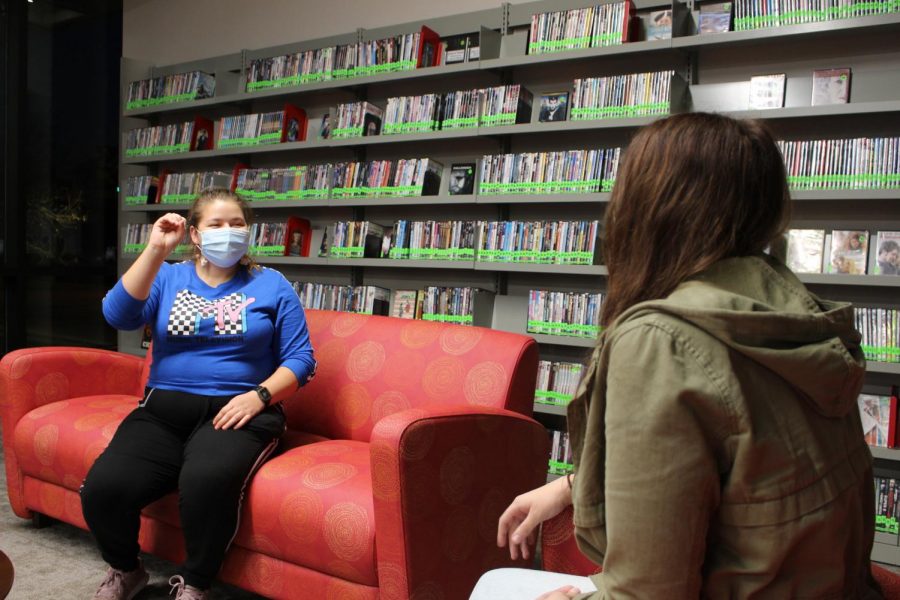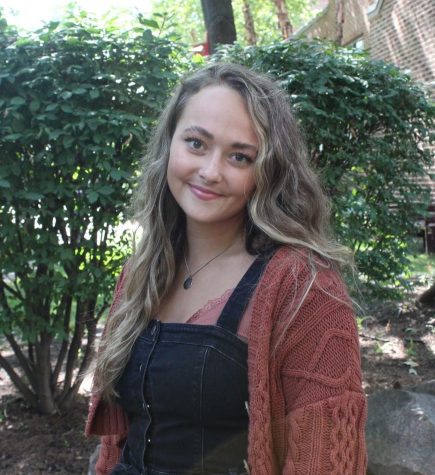Pandemic impacts deaf community
Deaf suffer as lack of inclusion due to COVID worsens conditions
Jessica Belousov (left), president of the ASL club, and Hannah Warner, a member of the club, practice sign language. The club strives to bring awarness to the issues the deaf community faces.
November 10, 2020
Many people have been affected by the COVID-19 pandemic. Quite obviously, those who have contracted the deadly virus and their families have been severely impacted by the virus since its explosion in March.
However, no one anticipated the immense impact the pandemic and lockdowns would have on communities suffering from mental illness and other conditions, such as deafness.
On Gannon University’s campus, the deaf community is nonexistent, according to Michele Kretzing, Gannon’s American Sign Language (ASL) club adviser, as the student population is not large in comparison to other universities.
However, the deaf population in the Erie community and beyond is immensely affected by the pandemic due to mask mandates, as the main mode of communication between deaf individuals and hearing individuals is lip reading.
On campus, Gannon has an ASL club for people who want to learn sign language to communicate with the deaf or use the skill in their future professions.
According to Isabella Green, secretary of the ASL club, over 100 students are listed on the club’s EngageU roster, and the organization is still growing.
“Right now, the ASL Club is a budding organization on campus,” Green said. “We had only just started to gain a real structure and identity in the semester prior to this one, and then this semester hit and we seem to be in a period of figuring out what’s next for us.
“We are hoping to become very involved in Erie’s deaf community and hopefully raise awareness in the process.”
How has the deaf community been affected in the U.S. and beyond during this COVID-19 pandemic? This is an important question and is often neglected due to bigger concerns taking precedence, such as racial injustice, finding a vaccine for the virus and the election of the 46th president.
In reality, though, deafness affects nearly 10 million Americans, 10% of whom are completely deaf, so this is a grand-scale issue.
Jessica Belousov, president of Gannon’s ASL club, weighed in on the challenges faced by the deaf community, especially within the last seven months.
“I think the deaf community definitely has been impacted by COVID-19 in several ways,” Belousov said. “First, I’ll start off by saying that my mom is deaf and is very involved in the Erie deaf community. Thus, most of this information I learn is from her.
“The most obvious way the deaf community has been impacted is by the difficulty in communication with hearing people. Before the pandemic, many deaf people had to rely on lip reading.
“Now, that is impossible, unless someone is only wearing a face shield or no mask at all, which is dangerous because of the pandemic.”
Communication is one of the largest obstacles of being deaf or hard of hearing, even during “normal” times. Belousov, however, offered some different challenges faced by the deaf community that the public may not even consider.
“Also, it can be hard to get accurate or clear information,” Belousov said. “News sources often rely on auto-captioning techniques. So, when a local news source is reporting an update or important information about the virus, deaf people have to rely on the auto-captioning system, which is very flawed and inaccurate.
“These systems only give a general idea of what is going on because of the many lapses and uncoordinated text and speech times.”
With this information in mind, it is crucial that news stations, local and national, keep the deaf community in mind when they go on air.
Arguably, individuals with disabilities are the most panicked right now, as they have lost most of their resources as Belousov suggested. So, their sources of information, which most American people extract from the news, must be reliable and consistent in order for dependable understanding, especially during a global pandemic.
As well as losing resources in the Erie community, the deaf population of Erie County has lost its sense of community by following CDC safety guidelines.
“Because of COVID-19, the Erie Silent Club, Erie’s local deaf nonprofit, is unable to host functions,” Belousov said. “When they do, it is usually for e-board meetings, or is very limited. They host parties for every major holiday like Easter, St. Patrick’s Day, Fourth of July, Halloween, Thanksgiving, Christmas and so on.
“Now that can’t happen because of the pandemic. So, deaf people have lost a lot of the socialization and support from other deaf people, which they were getting before the pandemic.”
The deaf community is suffering during the COVID-19 crisis, but Kretzing offered an insightful point.
“I do think the deaf community has suffered more [during the COVID-19 pandemic],” said Kretzing. “Is it straight out due to neglect?
“They are neglected often even when it is not a pandemic. Deaf consumers whose primary language is American Sign Language require an interpreter in many settings. Many service providers and businesses and organizations do not want to pay the fees for an interpreter.”
This neglect was seen at the first presidential debate, as there was no interpreter, so the deaf community could not hear what their presidential candidates had to say about the issues plaguing our country and its future.
However, she did offer some insight into how the pandemic has worsened conditions for the deaf.
“One specific way the pandemic is worse for the deaf community is regarding telehealth,” said Kretzing. “These are easy for the hearing community, but if you are deaf, you still need the interpreter.
“Also, Zoom is hard for a deaf person because they have to follow the boxes with fast-paced change of speakers. In addition, if a deaf person had to go to the emergency room, there were no interpreters, and everyone is masked. Communication could be almost impossible. People have had to make exceptions.”
Although the pandemic is going to end eventually, in terms of inclusion and advocation, the American people, especially news stations, broadcasters, and health care professionals, need to be more conscious of those with special needs.
As helpful as it is to ask what can be done to help those in the deaf community, it is most effective to ask a deaf person what they need, as Belousov suggested.
“I think the best way to figure out how to help deaf people is to ask deaf people,” Belousov said. “I know that’s not always possible, but they’re the best way to understand deaf culture and deaf needs in general. They are also the best option to teach ASL classes and even interpret.”
A good step forward for those interested in further advocating for the deaf community is learning how to communicate in a way that is easiest for them, not what is easiest for the abled-hearing. To do this on Gannon’s campus, you can join the ASL club, as it is open to anyone.
“You can find a request to join the club on EngageU,” Green said. “If you have any questions or are on the fence about joining, follow us on Instagram at @gannonasl and DM us there, or reach out to any of our board members.”
Meetings are typically held once a month in person, but they are hoping to meet more as they can begin to host more events post-COVID.
ALI SMITH







